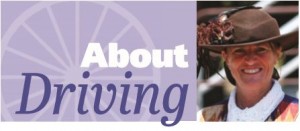 Here are some answers to common questions in driving:
Here are some answers to common questions in driving:
How do I choose a horse for driving?
The breed of the horse isn’t important, nor is the size important, other than finding the perfect horse for the job intended. My first requirement is the horse shouldn’t go into full training until it’s mature enough mentally and physically to do so. Personally, I usually like to start a horse at age 3 or older. Next, I look for a good mind and calm attitude. I want a willing and obedient equine, who will take to training. It should be sound with fair conformation. Older, well trained saddle horses, often take to driving training quite well.
How do I balance a cart?
A cart is like a teeter-totter, which must balance from the axle which serves as the fulcrum. First, have someone sit in the cart. Next, lift the shafts (from the point where the shaft loops will be, which is about 12 to 16 inches from the tip), slowly upward until you find where the cart wants to find a neutral weight in your hands. Hopefully, it is when the shafts are level- if not, then the weight of the people must be over or behind the axle, until you find neutral weight. Too light in your hands at level? Then move the weight forward slightly before the axle. Two people in the cart will change the weight and balance from one person. Harness the horse, then measure from the shaft loop to the ground. Whatever measurement that is, the cart should be balanced at the same measurement when holding the shafts, when loaded. Move the shaft loops up or down one hole.
How do I measure to order a harness?
All harness makers have a commonly used chart that they will gladly send you with the required measurements for your equine’s harness. This is very important, as not all equines are shaped the same. Some equines might need a larger or smaller part than the standard for their size.
Bridle: Measure from corner of the mouth over the poll to the other corner of the mouth.
Noseband: Start your measurement two fingers down the face from the cheek bone point.
Browband: Measure from just behind the ear across the forehead to the point behind the other ear. If your horse is particularly fine or thick through the throatlatch, then measure that, too.
Breast collar: From the area behind the shoulder and above the elbow, around the chest (where the neck meets the chest), and to the other side.
Saddle/girth: Measure around the horse from just behind the withers through the girth area (no more than one hand behind the elbow).
Back band/turnback: From just behind the withers to the top of the tail.
Breeching: From the flank, around the butt (at the widest part), to the other flank.
Hip strap: From the breeching over the hip to the other side. Also be sure to include the height and approximate weight of the equine to the harness maker. If you are looking at a used harness, then take these measurements with you to look at the harness for fit. Also, be sure to tell the harness maker what type of carriage you will be using. Some carriages use slightly different shaft loops, breast collars, and saddles.
What type of whip do I need to use?
A whip should be balanced in your hand — neither too top heavy, nor too large or small to hold, but fit comfortably in your right hand. The shaft of the whip should be long enough to tap the rib cage, and the lash, long enough to touch the equine’s shoulder. Dressage whips and lunge whips are not recommended. Whips can cost from $30 to hundreds of dollars, depending upon quality. Harness suppliers usually carry good whips that aren’t usually carried in tack stores.
How long does it take to train a driving horse?
Every horse is an individual and learns at a different pace. In the old days, a young horse was trained in a few days’ time by very experienced horsemen. In that era, a horse might be driven 40 hours in a week, while being hitched next to a more experienced and trained horse. In our modern times, we rarely have the luxury of this technique, and it takes quite a bit longer. Forty hours of training time could actually be weeks to months of training now! Your equine needs to be comfortable wearing a harness including breeching and blinders. It should be trained to accept a whip touching its body. A whip is appropriately used in driving and is a tool, such as leg cues are used in riding, for lateral movement as well as forward movement. Since some carriages can be very noisy, the equine should be gently accustomed to various noises (like a tire dragging in the dirt, plastic bottles tied together, trash cans rattling, flags snapping, etc.) and conditioned not to spook at them. The equine should be comfortable pulling an object behind them with the collar and traces, as well as shaft simulators. The shafts of a carriage can be confining to a horse, and must be slowly introduced as to not cause panic by their restriction. The equine should be comfortable with each step of the process before the next step is introduced. These are the building blocks to training the driving equine.
Where can I find books on driving?
The library and internet are wonderful sources. The CAA carries a large selection of books: http://www.carriageassociationofamerica.com/
Are there rules for driving?
Yes. The USEF/ ADS rulebooks can be found online. The USEF has adopted the ADS rulebook for pleasure driving and combined driving: americandrivingsociety.org
~Trish
September 7th, 2016 at 5:11 pm
Great information. I wish we had more people like Trish. I really would love to learn how to drive again! Thank you